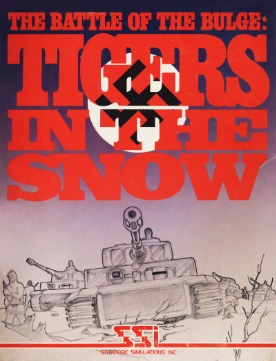
Leutnant Narwhal, why isn’t the 2nd Panzer Division moving? They are blocking the way!
Well, they said they will only move after we have moved!
That’s stupid – they are in front of us! Can we try to get around them? Any solution, Leutnant ?
Well, We can try to cross the river… maybe there is a bridge.
Don’t you have a map to check that? Is there a bridge, Leutnant Narwhal ?
We won’t know whether there is a bridge until we try to cross it, General!
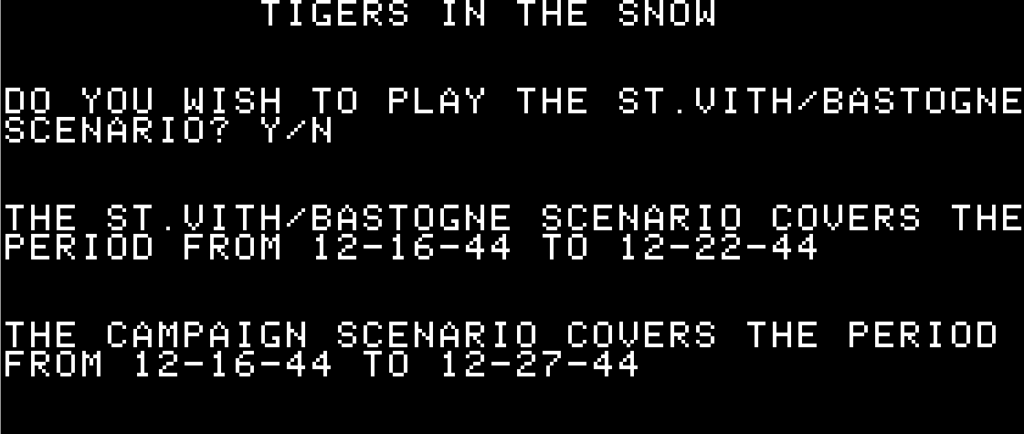
The Battle of the Bulge: Tigers in the Snow is (with the Battle of Shiloh, released at the same time) the first game of the Tactical Design Group, a company founded by David Landrey and Charles Kroegel. All the Tactical Design Group games were published by SSI, and the Tactical Design Group would not last – in 1983 both Landrey and Kroegel would join SSI.
I’ll be talking more about Landrey and Kroegel in the future. Kroegel seems to have started his career with Tigers in the Snow, but Landrey is in 1981 one of the most experienced computer wargame designers on the market – second only to John Lyon in terms of sheer volume of wargames to his tally. He already released 3 TRS-80 games in 1980: Battle of the Bulge: St Vith, Battle of the Bulge: Bastogne and D-Day: The Invasion of France. Sadly, while I could find those games (with the help of Ira Goldklang), they cannot be played without their manuals so I have to skip them for now.
The Battle of the Bulge doesn’t need much introduction. Starting in December 1944, it is the last German offensive in the West. Using the few reserves available to Germany, Hitler ordered his generals to launch an offensive through the Ardennes, hoping to use the element of surprise to trounce through the Western Allies, recapture Antwerp, cut the Allies in two and force them to negotiate.
The game starts on the 16th of December 1944 and can be played as either side. As all wargamers know, WW2 is designed to be played as Germany, so I take the Germans, give the Allies a small advantage (difficulty 6 out of 9) and start the game.
Initial situation :
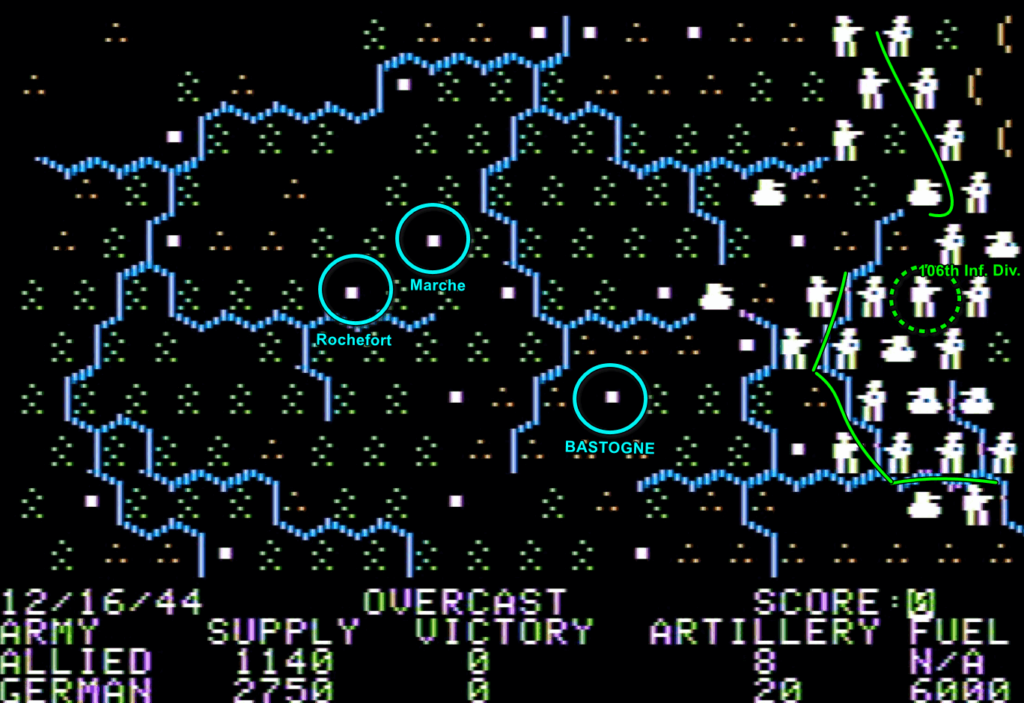
The Germans are the “dotted” units facing West, the Allies (exclusively Americans at this point) are facing East. The Americans are few in number and individually their units at the beginning of the battle have less “Combat Value”, which is both combat strength and health points. This reflects the fact that historically the Americans have been caught flat-footed by the offensive, and the only units in the area are either inexperienced units or depleted veterans.
One of their units (the 106th infantry division) is totally surrounded, and the rest of the Americans are spread out – the units in the center are the weakest but they are protected by the Our river.
My objectives are to take Bastogne as soon as possible (it yields 50 points by day), then Rochefort and Marche (25 points by day each), and then try to evacuate units West or North. Of course, the Allies will do everything to stop me.
I have 12 days (=turns) to bring Hitler his victory in the West. Of course, I am at risk of running out of fuel long before that, and while the weather is for now so bad that the Allies cannot use their air force – this won’t last.
Objective one: To Bastogne!
My first objective is Bastogne! If I don’t take it I don’t see how I can take Marche and Rochefort, and without Marche and Rochefort forget about evacuating units.
I have no time to lose, so I go all out or rather, almost all out. While I burn all my available artillery in the initial assaults, I choose “Medium Attack” when prompted.

Why don’t I use “Major Attack“? In Tigers in the Snow, your units sometimes refuse to do “Major Attacks“, even if they are overwhelmingly superior to the opposition, and when they do so they pick another type of attack randomly, and you have 33% chance that your daring panzer commanders opt to “recon” a totally surrounded and depleted infantry unit. I am not surprised. Men are always ready to sing the Panzerlied when the colonel is around, but when it is time for a Major Attack there is no one. Boys. Too many boys.
The enemy position in the North (the top 3 infantry units) is solid, so I choose not to attack it, to preserve my supplies for the long run.
In any case, despite the artillery support, I only manage to cross the Our river in one location, in the middle. The surrounded 106th division survives.
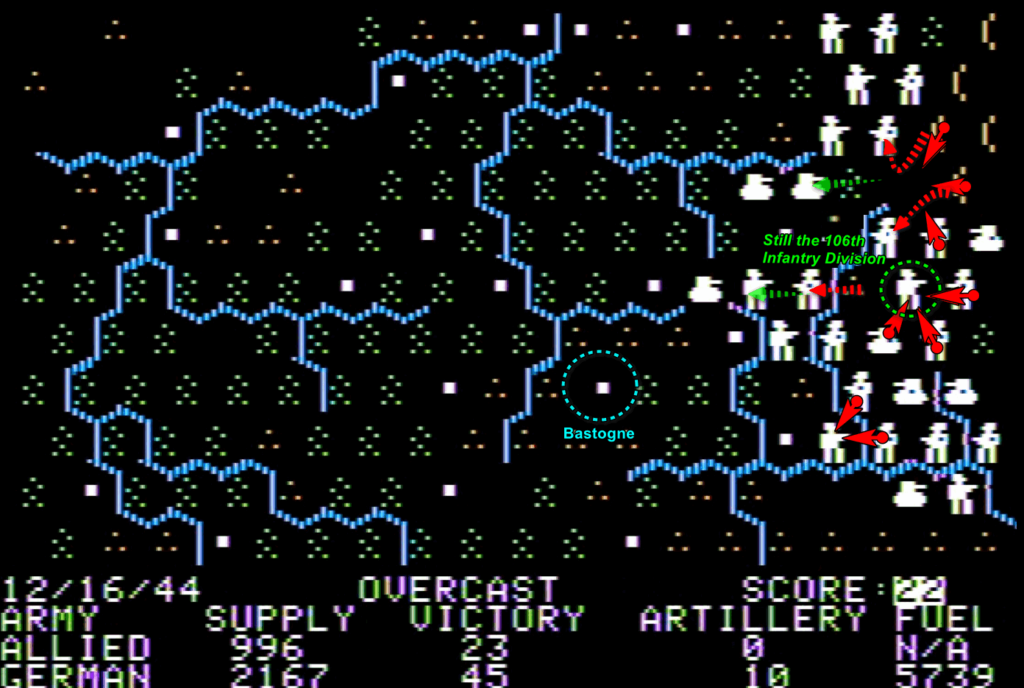
The Americans immediately plug the holes in their lines with their weakened units, and at the end of the day their first strong reinforcements arrive – but then so do mine :
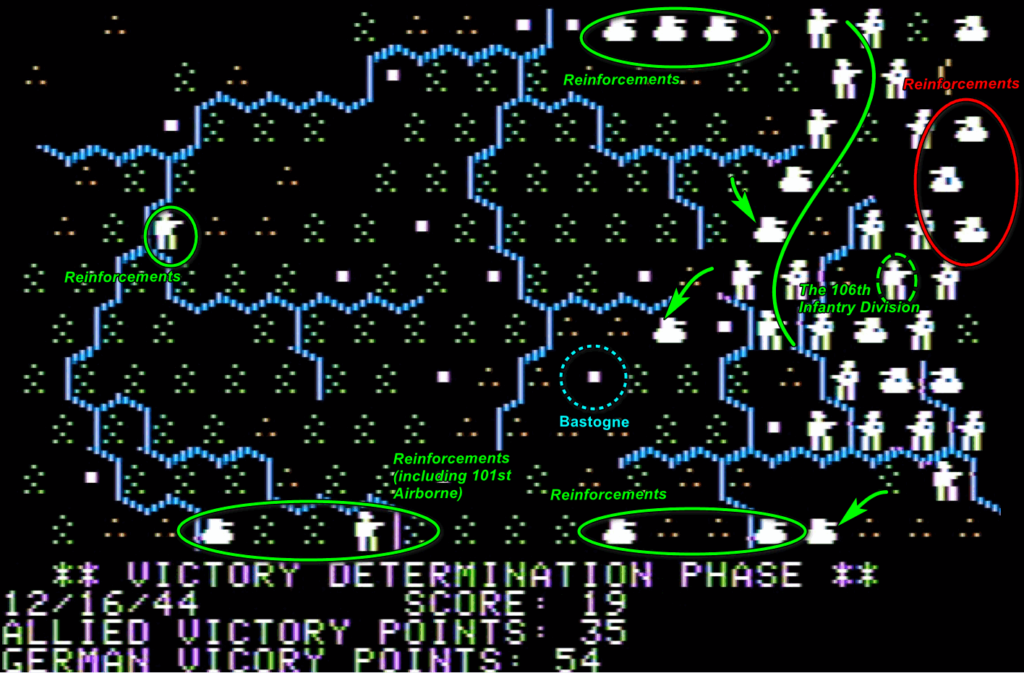
On the 17th, I cross the river and infiltrate everywhere I can, even if it means that those infiltrating units could be isolated and out of supply in the future :
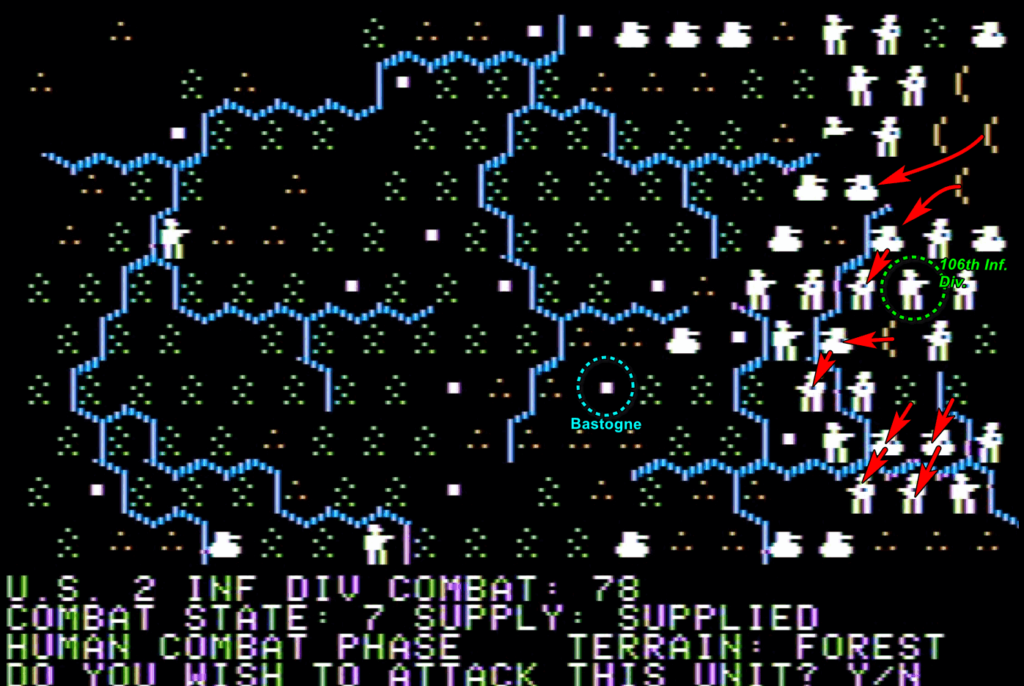
As you can see, I could not cross with my tanks. Crossing a river takes a random number of movement points. If that random number is above what you have left for the turn, the game will tell you that “the bridge is blown up” or that there is a “traffic jam” – ending your turn. The extra movement points are wasted.
This time, my attacks are way more successful. In the center, one enemy unit is annihilated; in their pursuit, two German divisions (one armoured, one infantry) meet an American armoured unit that was moving toward Bastogne, and a second battle against it triggers another pursuit. And just like that my two divisions crossed one-third of the map and are next to Bastogne. Realistic? No. Efficient? Yes.
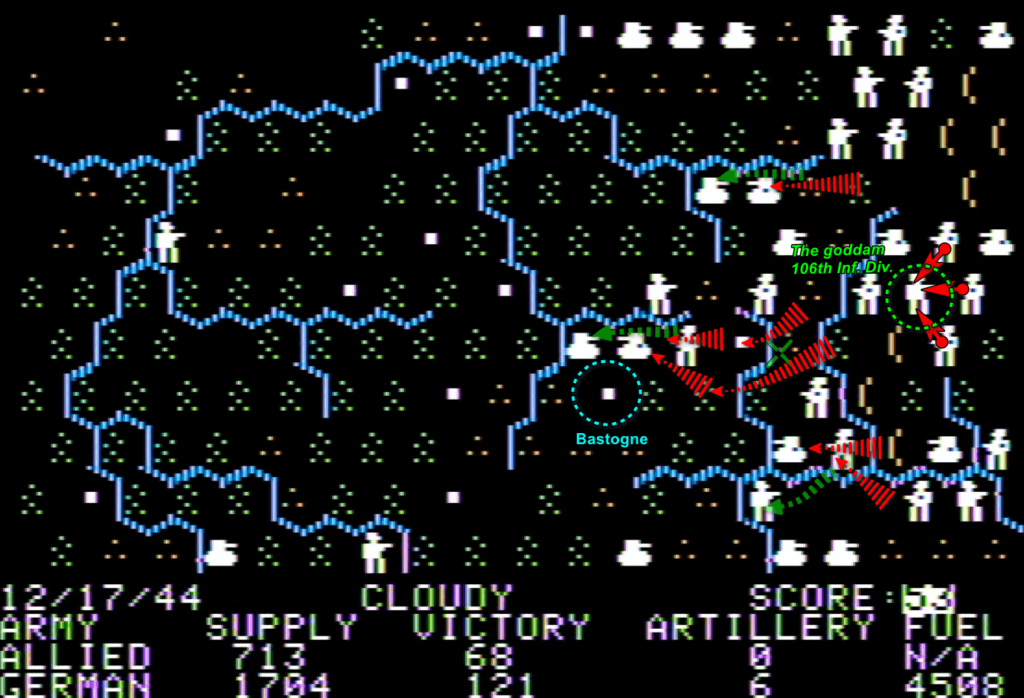
I am also successful in pushing the Americans North and South, my only setback is that the 106th division is STILL holding and blocking a chunk of my forces with its zone of control.
The Allies try to reinforce their line North & South, but in the centre they have almost nothing, and I take Bastogne on the 18th. It took me 3 days; historically it took the Germans 5 days to reach Bastogne, and even then they could never take it. The 101st Airborne, which historically successfully defended Bastogne, hasn’t even arrived yet
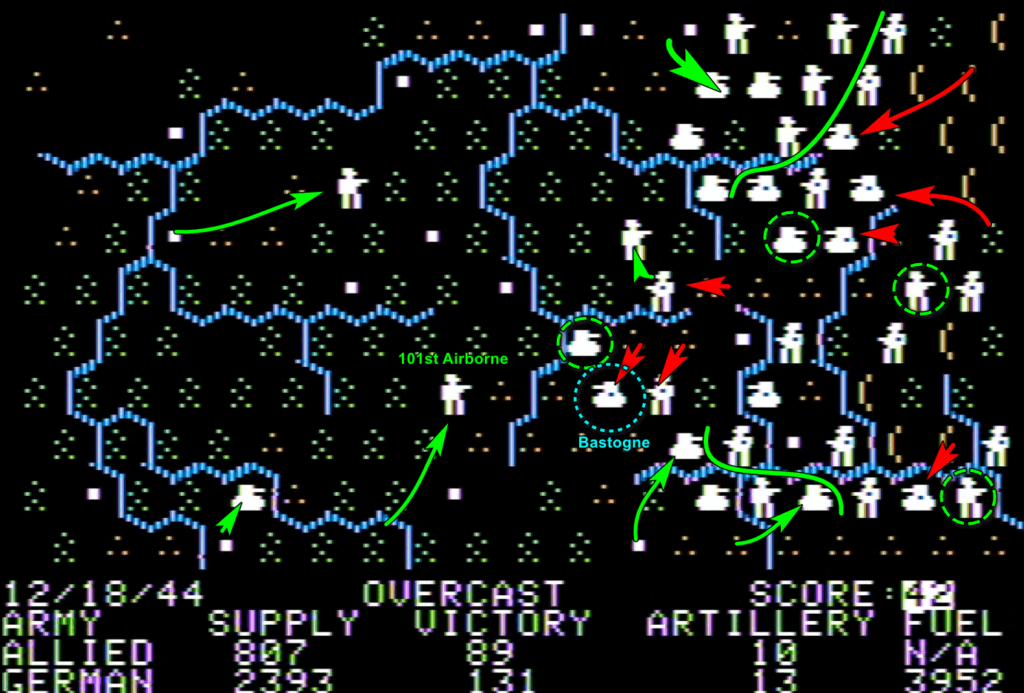
Objective two : Marche and Rochefort !
I am in a good position around Bastogne but elements of the 9th Armored Regiment are well situated to block my movement, in particular the Combat Command B (CCB) resists violent assault and stops the Germans from pouring West. I have only one infantry unit well positioned to move toward Marche, but it won’t do much alone.
At least, I finally got rid of the 106th.
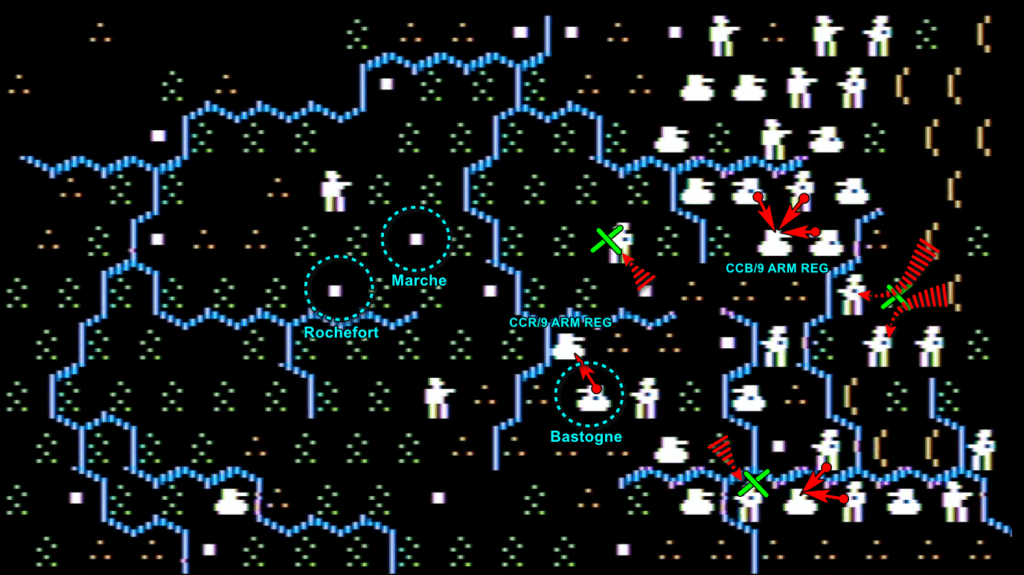
On the 19th of December, the CCB finally goes down and the way is open. Fuel and supply levels are acceptable – I am confident.
Near Bastogne, the Combat Command R (CCR) also goes down, but it is replaced by the 101st Airborne.
Finally, I receive some reinforcements – three Panzer divisions. The infantry that destroyed the 106th is rotated South to clear the way, and they can just as well attack the remaining isolated infantry (4th Infantry Division) the Americans have there.
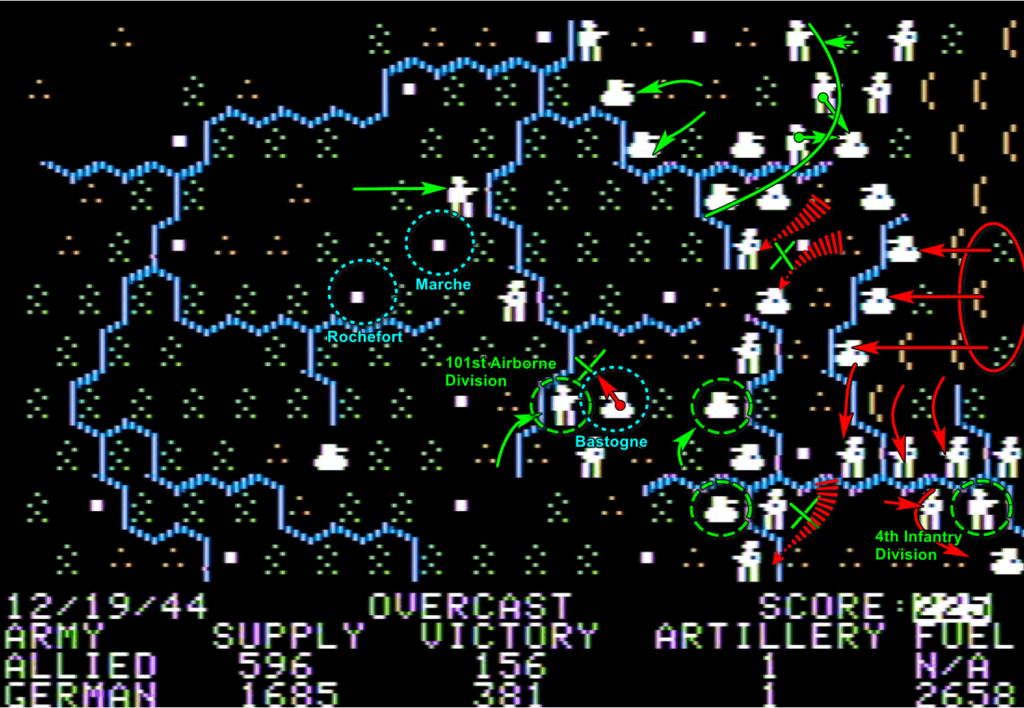
But I need to be quick, the Americans are crossing in the North to block my way. More worryingly, the weather clears up, and now my units lose up to one-quarter of their movement speed due to enemy air superiority!
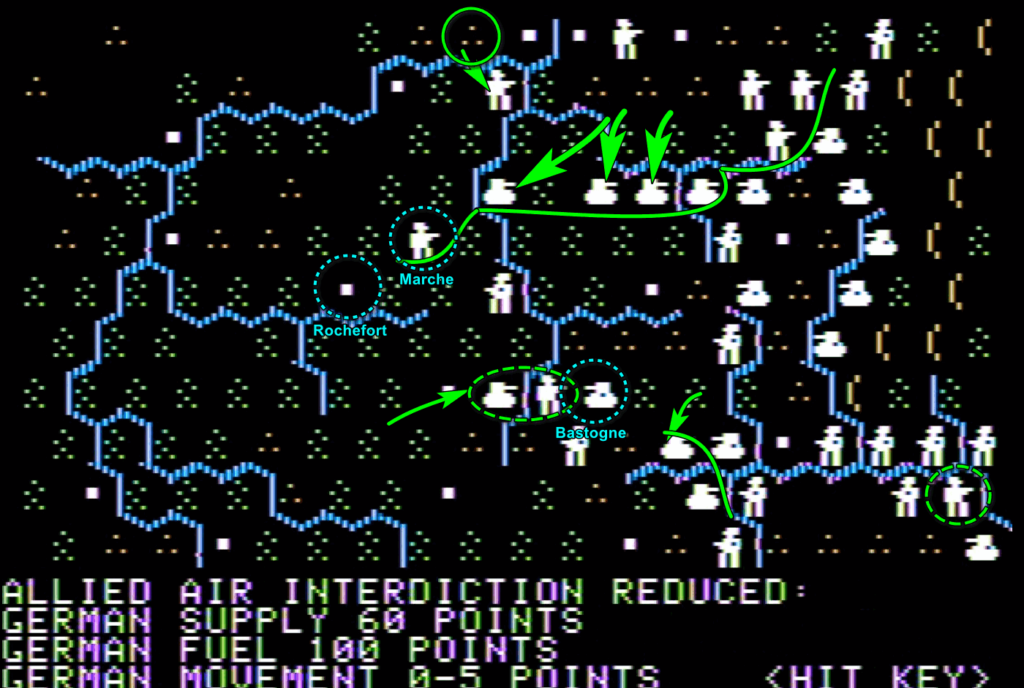
I try to move as fast as possible pushing an armoured tip toward Marche and Rochefort – but I don’t have enough local superiority to engage the enemy.
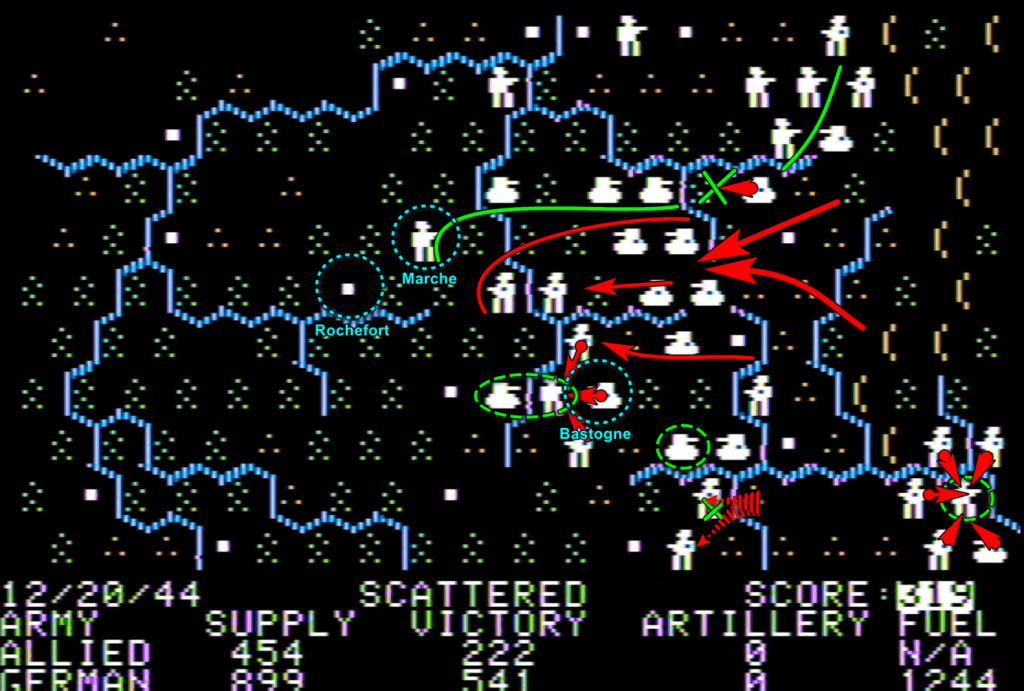
In response, the Americans… don’t try to attack. Instead, they retreat and try to build a new defensive line behind the Hourthe river. They also receive new reinforcements North & South.
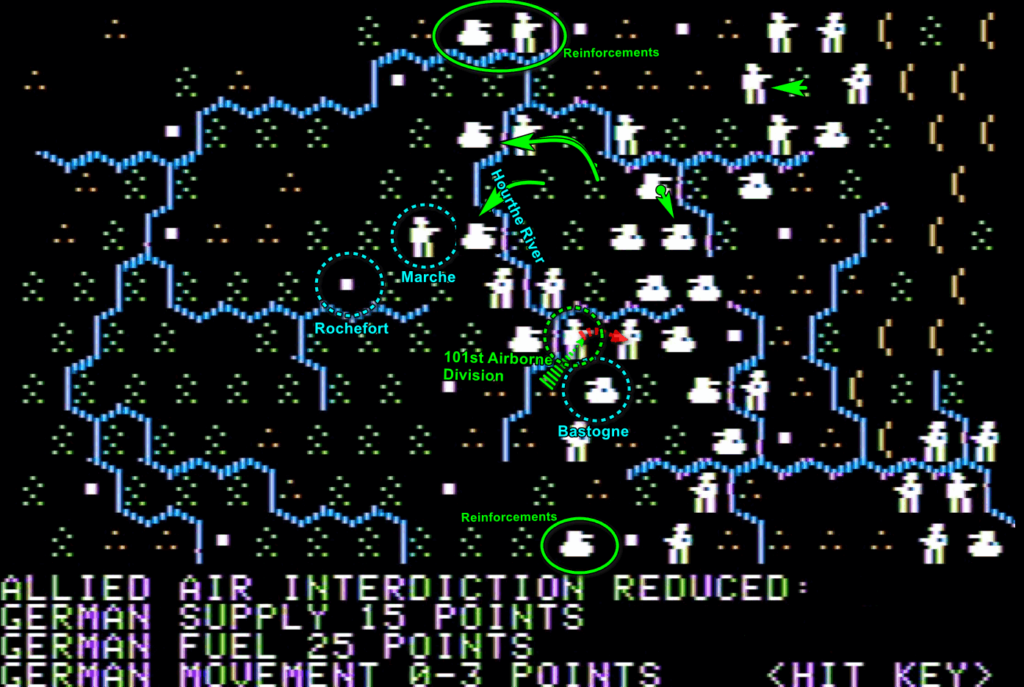
On the 21st of December, the Americans are waiting for me on the Hourthe, but I cannot even reach them. The 101st Airborne and the Combat Command A (CCA) from the 7th Armored are exerting zones of control that halt my troops. Zones of control are not absolute in Tigers of the Snow, so in theory I could still push forward, but there is a design flaw: units can only be moved in some specific sequence, always the same, so if the unit in the front moves last, everyone behind will have to wait. And this is exactly what happens here, I cannot proceed, and for lack of a better option I focus my attacks on the CCA – without success.
Moving and attacking with all those tanks costs me a lot of fuel. Supply, in a couple of days, moved from “good” to “way too low”.
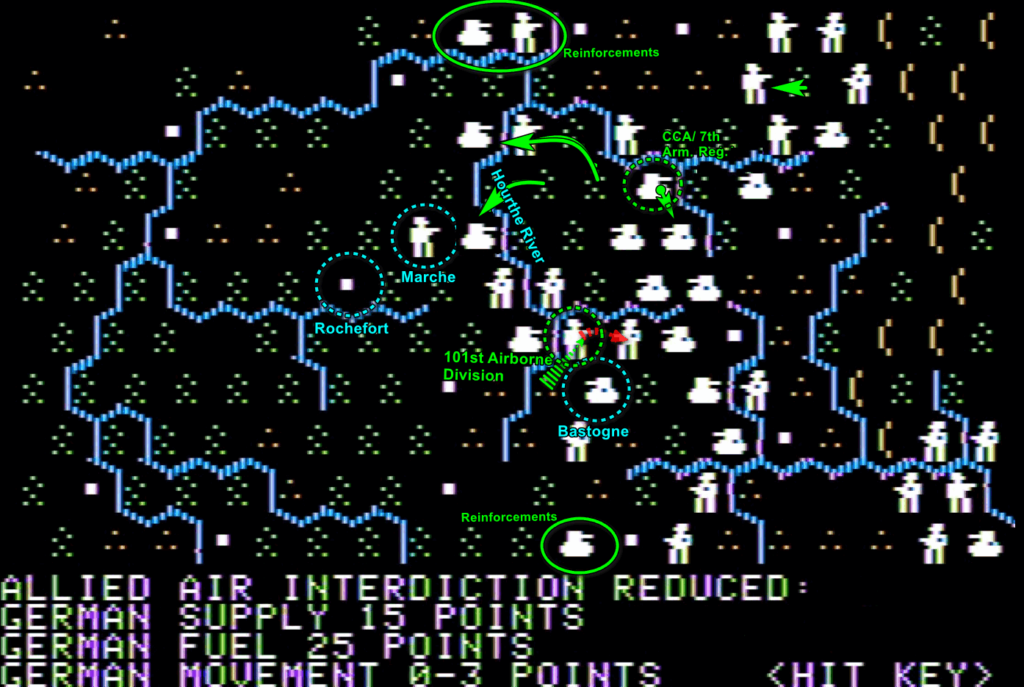
At last, I also finally get rid of the 4th Infantry Division in the bottom-right corner, and I am also trying to destroy the reinforcements in the middle-South (the 4th Armored Division) before it becomes a danger.
On the 22nd, more enemy reinforcements appear in the South, putting my local forces in a difficult position. I try to assault the 101st Airborne and its accompanying CCR unit (from the 10th division this time) from all sides, but they doggedly resist. The day is inconclusive.
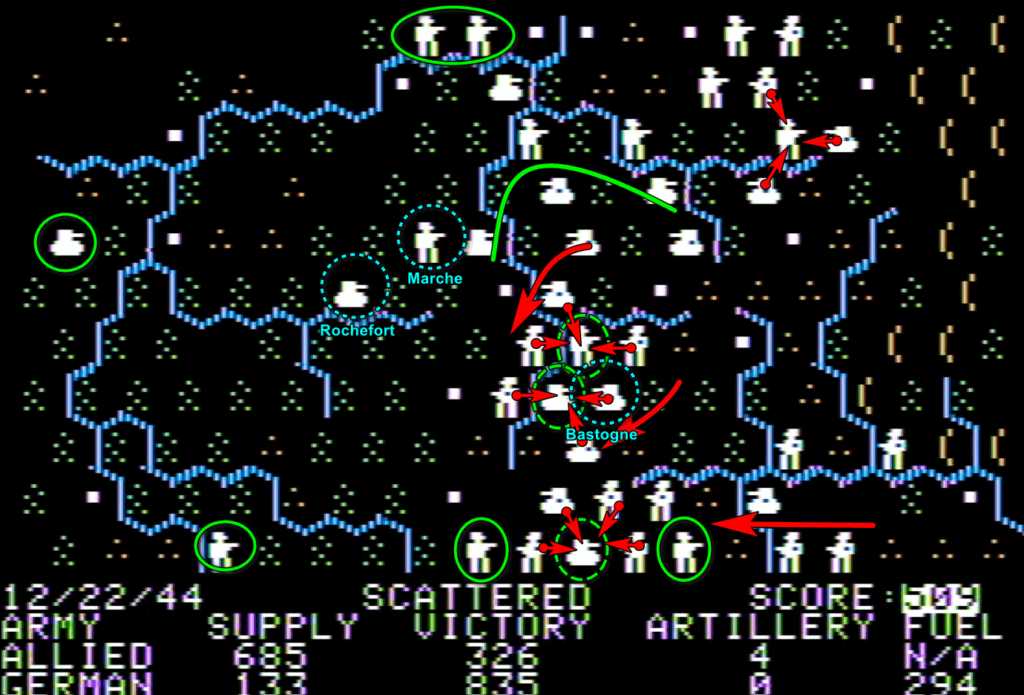
Things move again on the 23rd, and I finally get rid of several irritating armoured units here and there, but I am also pushed back on the sides.
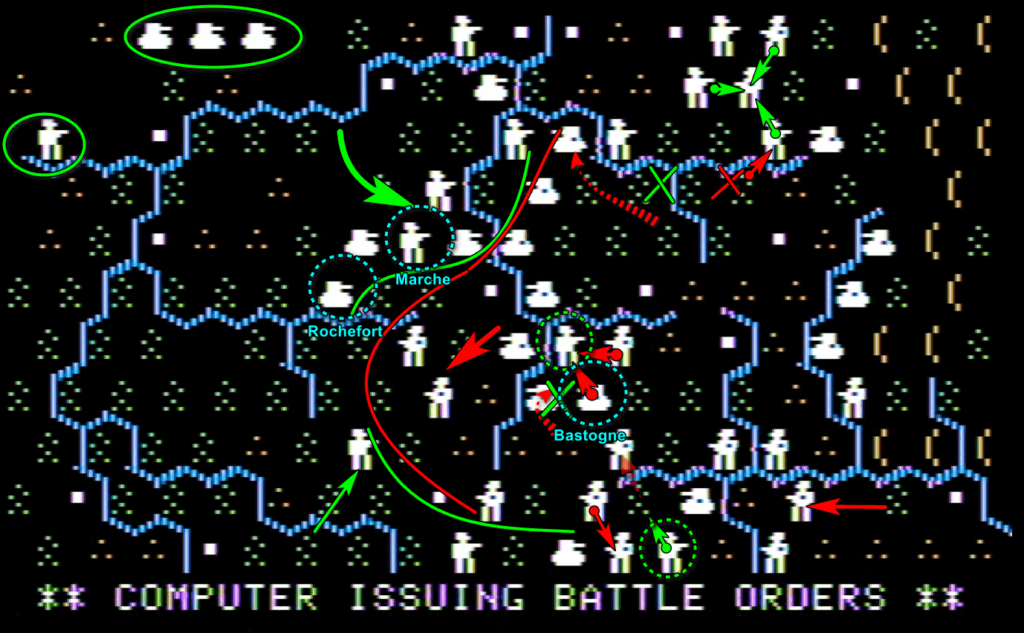
The enemy is receiving yet more reinforcements, and I am even threatened South of Bastogne at this point. I realize I am unlikely to take Marche and Rochefort – especially since I am almost out of fuel and supply.
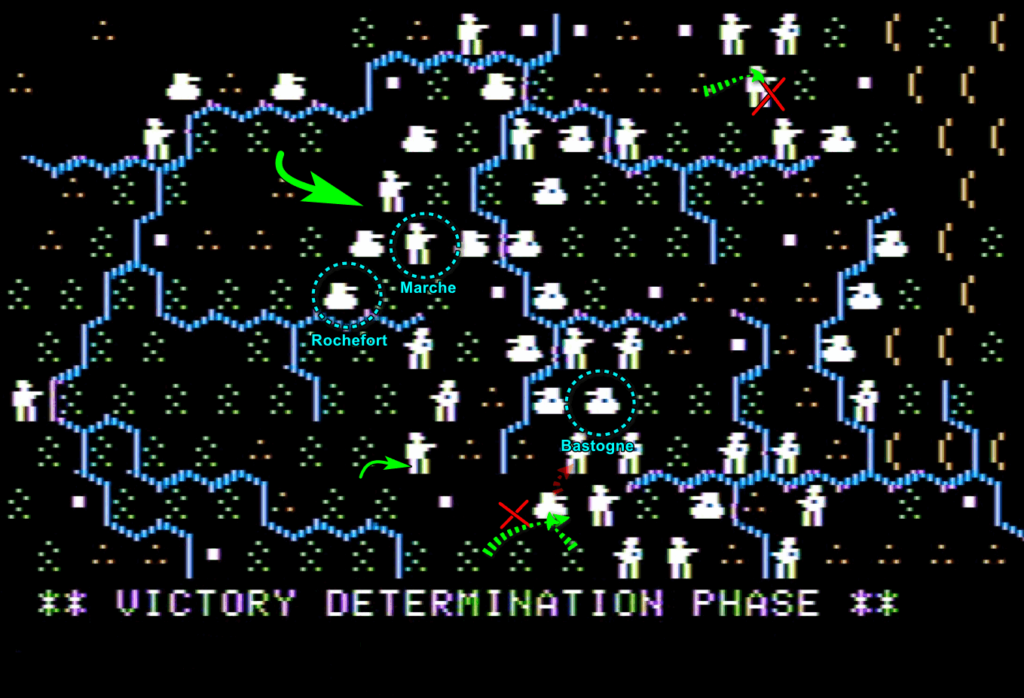
Objective three: Get points
Well, the dash to Antwerp won’t happen, so now my objective is more gamey: get as many points as possible by losing as few units as possible, and destroying as many as I can.
I pass the Hourthe river with my tanks to prevent the Allies from shifting reinforcements from the North to the South – my tanks are strong enough to avoid elimination, and with some luck maybe, just maybe, I can take Marche after all.
Something else happens: I accidentally abandon Bastogne, because the game never reminds you that it is Bastogne and it takes one key press to abandon a strategic position. Oh well, I will occupy it again tomorrow, right?
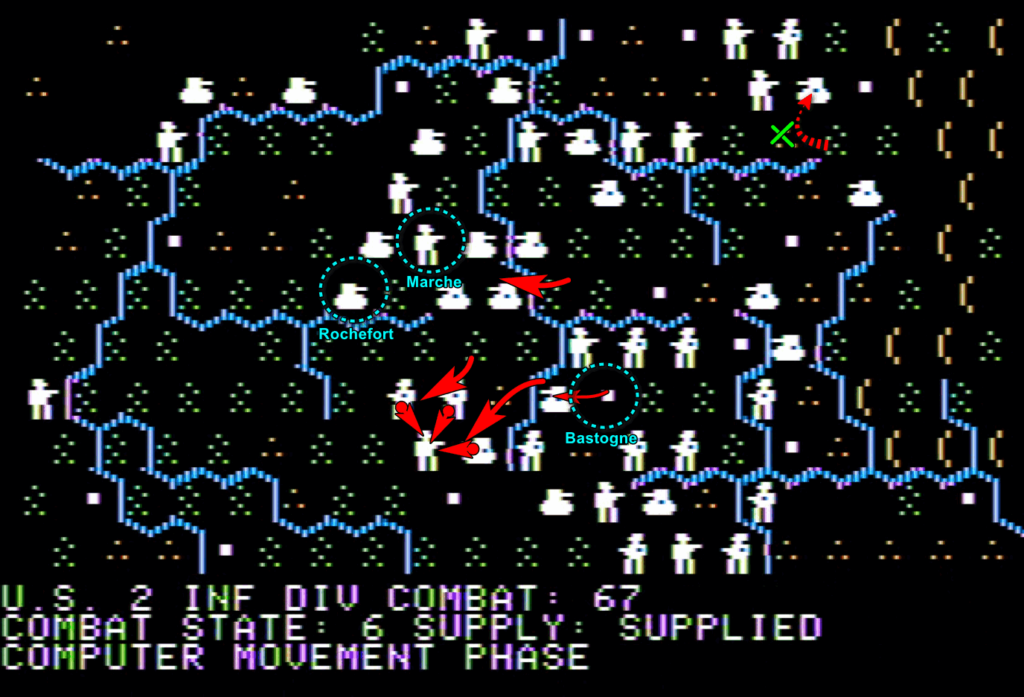
The Allies immediately counter-attack in the North, but they don’t do much except force one of my units to retreat. In the South though, the Americans are getting dangerously close to Bastogne.
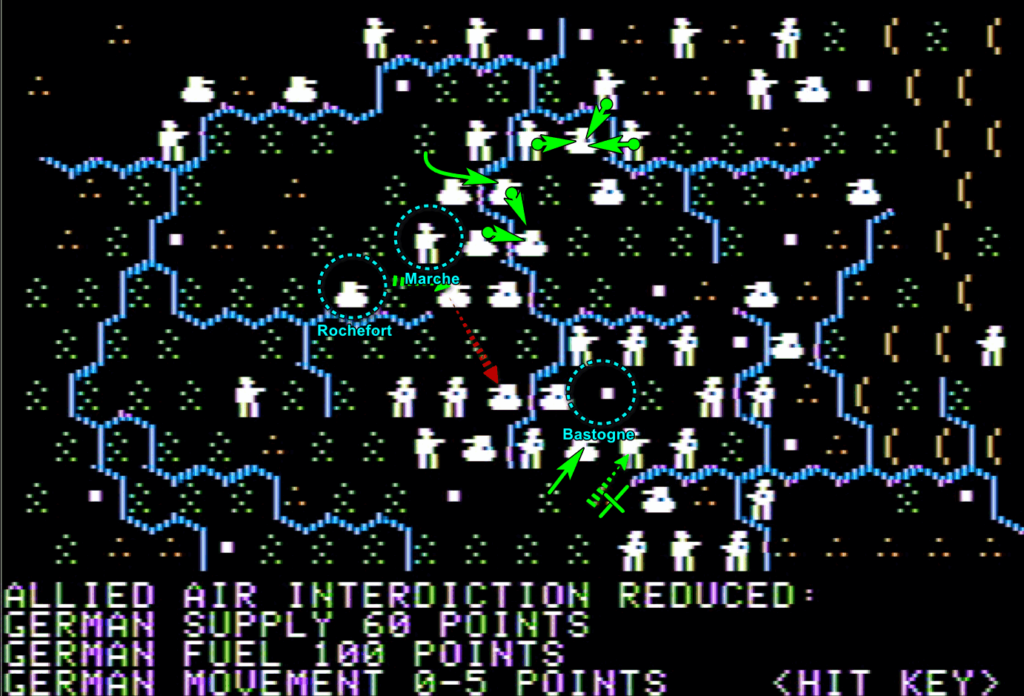
Allied air power destroys whatever little fuel and supply reserves the Germans can accumulate every turn, so most units are considered out of supply and fight at half-strength. I decide to preserve my forces in the North, and only fight near Bastogne, which is reoccupied…
… to no avail. The US 4th Armored Division manages to destroy the Germans who occupied Bastogne, and now it is theirs! Everywhere else, the allies reduce my perimeter, but they trade at 1:1 at best.
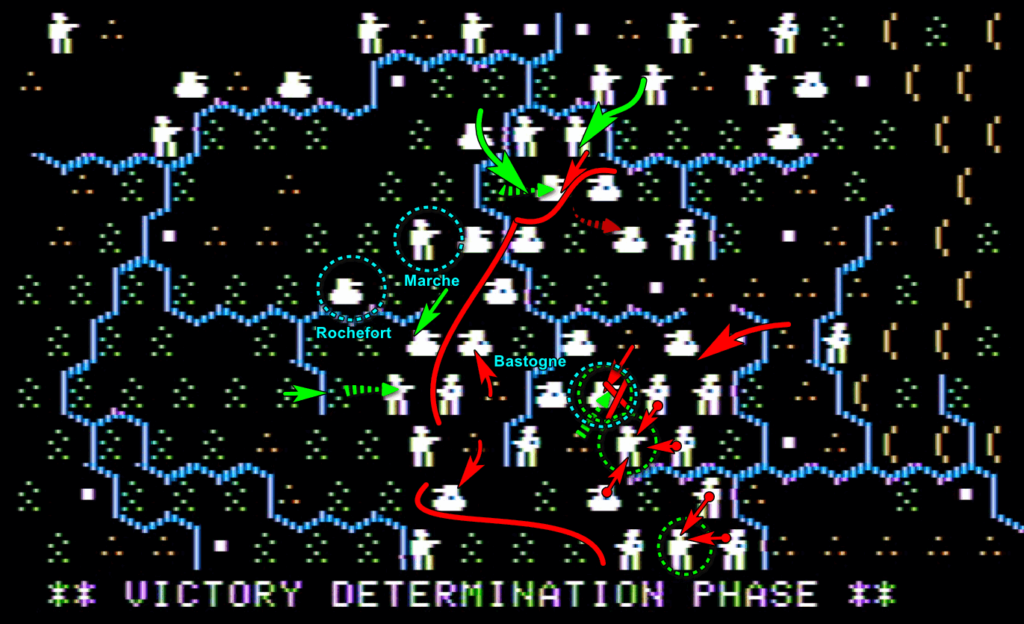
On the 26th, the little supply and fuel I can gather is only used to attack Bastogne, but still my troops don’t manage to push the 4th Armored Division.
I am finally relieved of command on the 27th, as the campaign ends. Even though I finally retook Bastogne, my perimeter is gnawed even more in the South, and several of my troops are isolated behind enemy lines. Hitler’s last hope has been smashed, though it is “only” a marginal victory for the Allies.
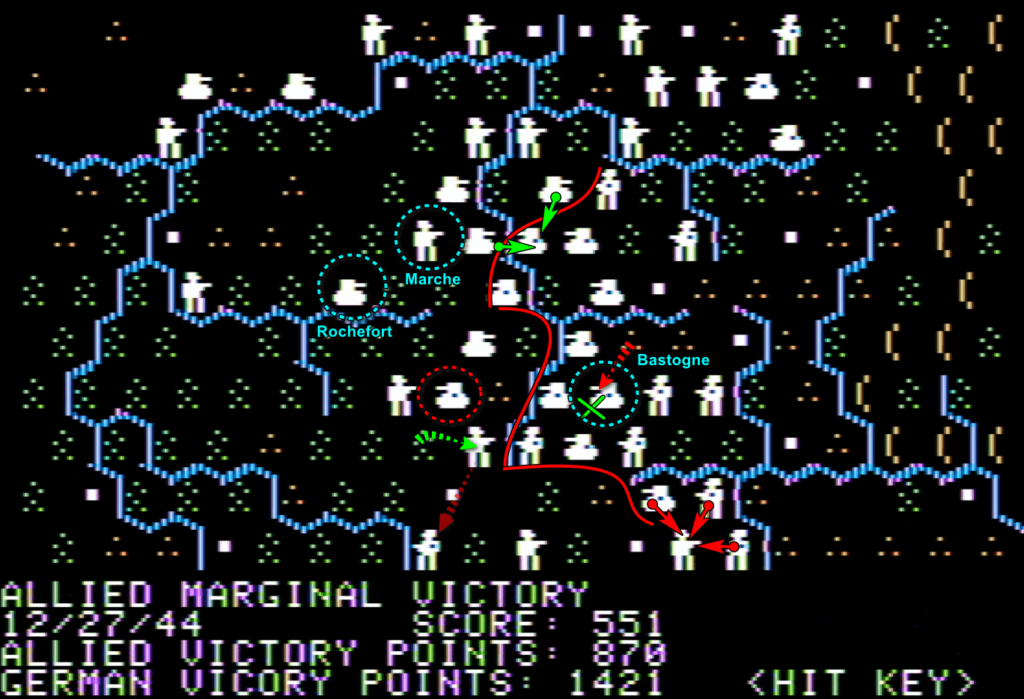
I end the battle with 551 points, when the threshold for German marginal victory is 700. Holding Bastogne for two more turns, as I would have without my order mistake, and being a bit more defensive at the end could have given me a “marginal” victory.
More fundamentally, I believe I made quite a few mistakes that cost me a more decisive victory despite a really good start. In particular, I should not have allocated troops to destroy the 4th infantry division (in the bottom-right corner) and then to try to destroy the Southern reinforcements – I should just have blocked them with a couple of units and used everything for a push in the centre, and then attack Rochefort and March from both the South and the East. As for evacuating units, eh, I was far from that.
Rating & Review
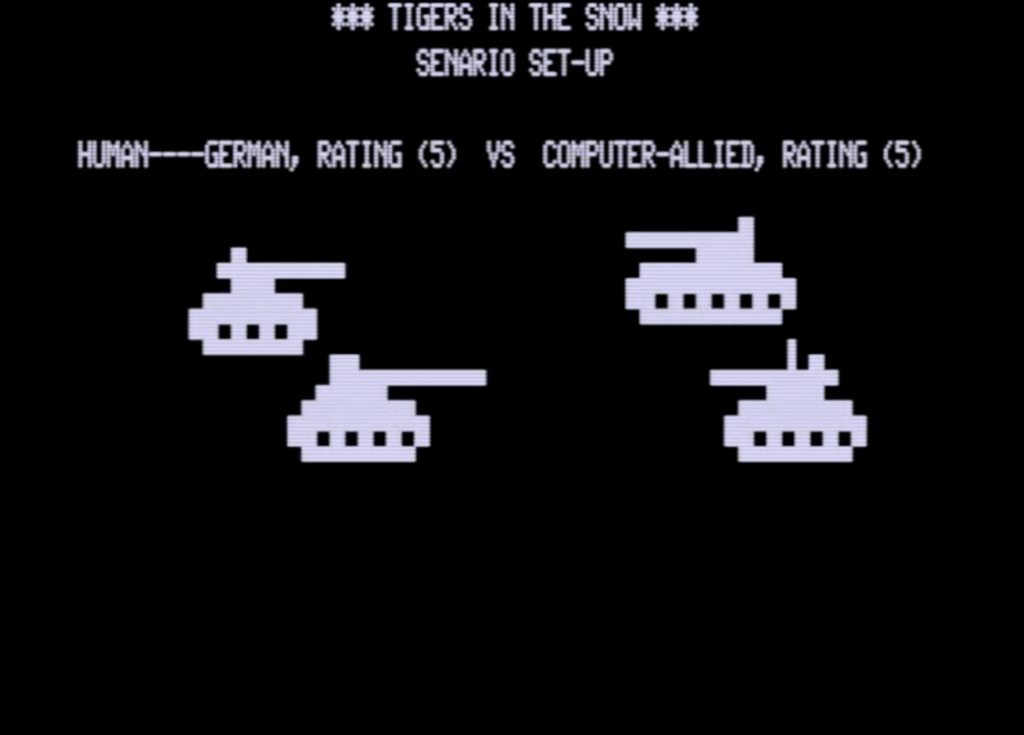
The Battle of the Bulge: Tigers in the Snow by the Tactical Design Group, published by SSI, USA
First release: October 1981 on Apple II and Atari
Tested on: Apple emulator
Total Hours Tested: 5 hours
Average duration of a campaign: 1.5 hours
Difficulty: Easy to play (1/5)
Would recommend to a modern player: No
Would recommend to a designer: No
Final Rating: Totally obsolete
Released in October 1981 at the same time as the Battle of Shiloh, Tigers in the Snow was certainly not an SSI flagship: it was sold at the lowest SSI price point and included very little beyond a couple of reference cards. Yet SSI tried something new: both Tigers in the Snow and Battle of Shiloh were the first games to be released on TRS-80.
Something about Tigers in the Snow seems to have made it easy to port, and it eventually supported Atari (1982), IBM PC (1982) and Commodore 64 (1983) – very few other SSI games supported that many platforms – though the versions have some differences.
Whatever the version, Tigers in the Snow is an enormous letdown: it is David Landrey’s third game about the Battle of the Bulge, but it makes many mistakes Landrey did not make in his first games. Indeed, while I could not fully play his earlier TRS-80 games (some rules are not enforced by the software and require players to enforce them based on a manual I do not have), I could test them enough to compare Tigers in the Snow. The comparison, apart from the graphics, is not in favour of the latter.
A. Immersion
Disappointingly, there is very little to put you in context: a couple paragraphs of historical background in the manual, and the names of the units in the game and in the reference card. That’s all. You don’t even have the names of the cities or the rivers anywhere in the game.

This is all the more frustrating since Landrey’s earlier games were much more comprehensive on this front: St Vith had a 20-screen-long historical introduction, Bastogne had 10 screens.
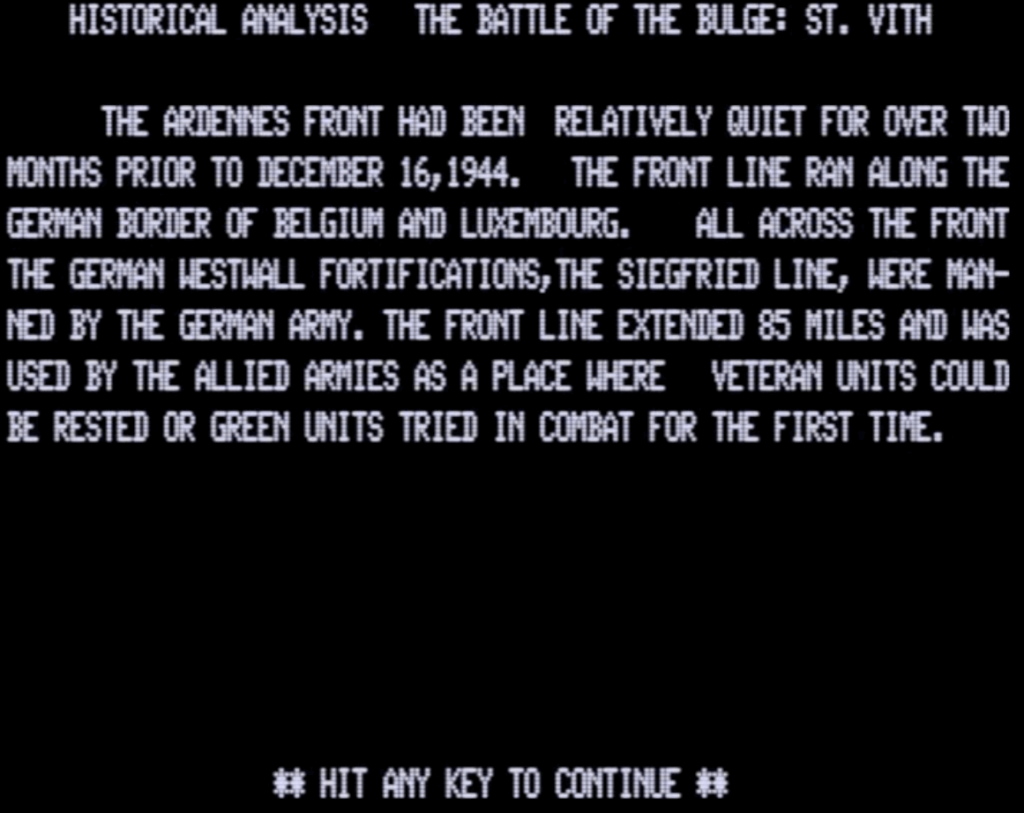
Moreover, both games had a cool intro where they displayed the names of the cities and rivers on the map :
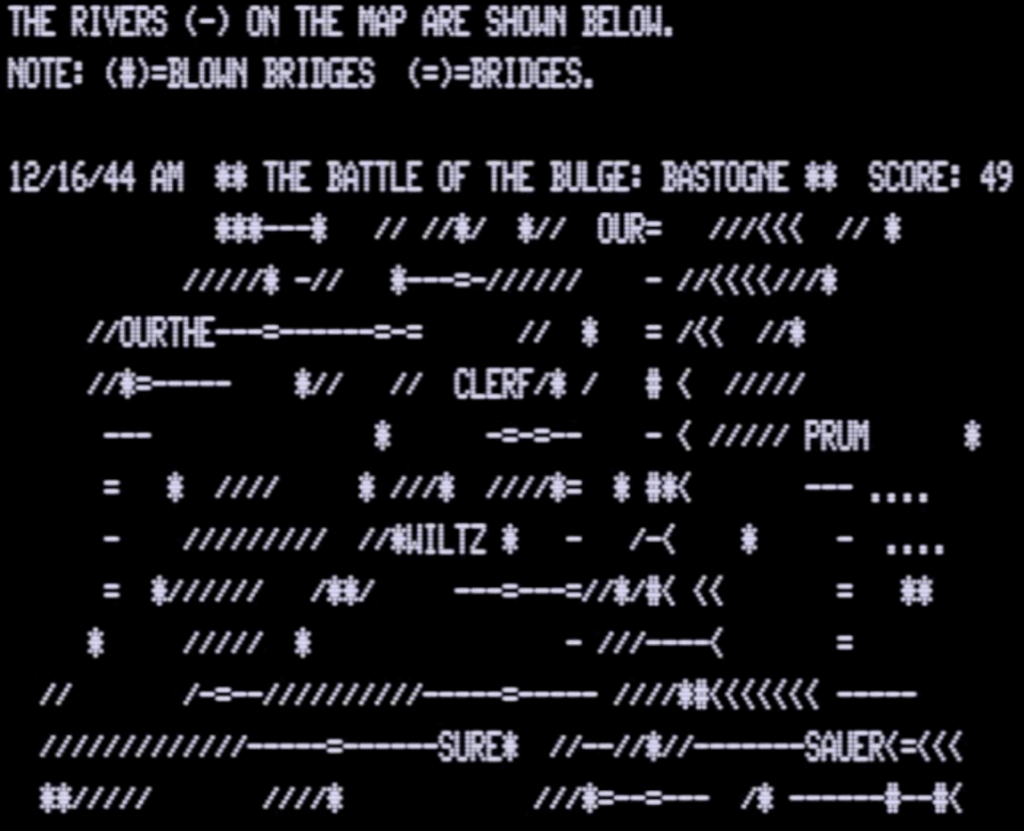
Moreover, I don’t think the game replicates well the unique circumstances of the Battle of the Bulge. In real life, the limited number of roads was a limiting factor for both sides (which is the reason why the Allies did not expect an attack in the area), and bridges were strategic locations to take, defend or blow up. In the game, there are quite simply no roads and you can cross the rivers at any point. Landrey’s earlier games on TRS-80 did have bridges, and you could even build pontoons or destroy them.
Without any names on the map, and without some of the most important constraints of the battle, the game feels very generic: it’s more Bulge-flavored than an actual wargame about the battle of the Bulge.
There is only one area where Tigers in the Snow on Apple II beats the earlier games: graphics. On Apple II, they are not great but at least they are clean. Even the TRS-80 graphics are better than Landrey’s earlier games, but well, there is only so much that a TRS-80 can do :
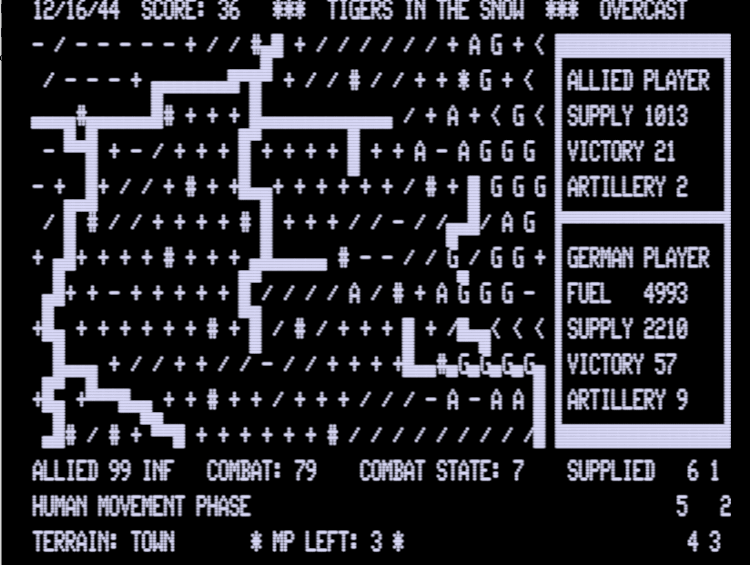
It still looks better in my opinion than the later Atari version, which you can see below in all its ugliness :
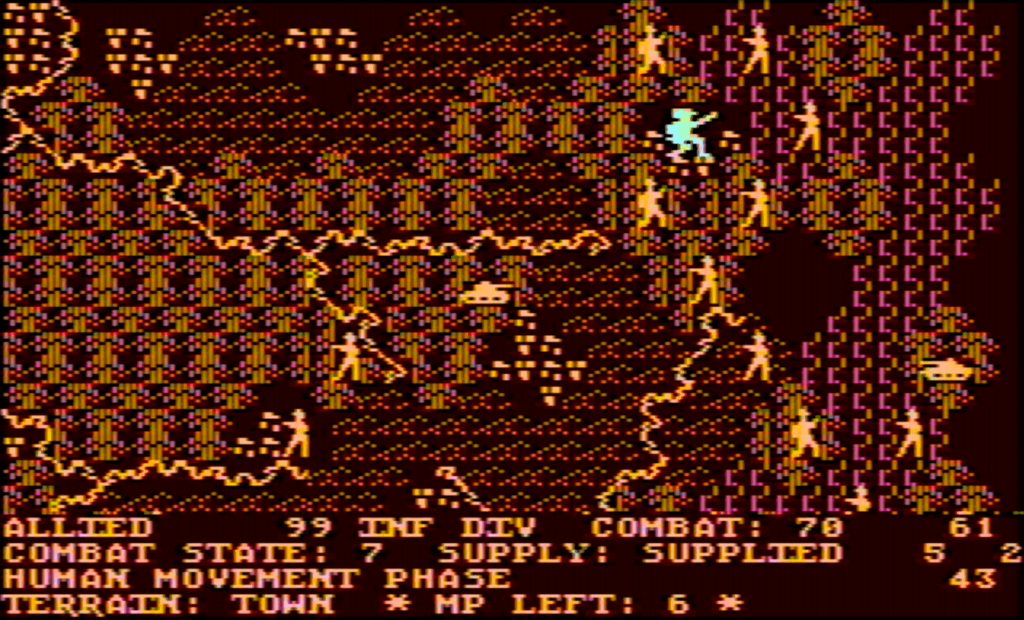
The IBM PC is as clean as the Apple II version, while the Commodore version is doing something a bit different :
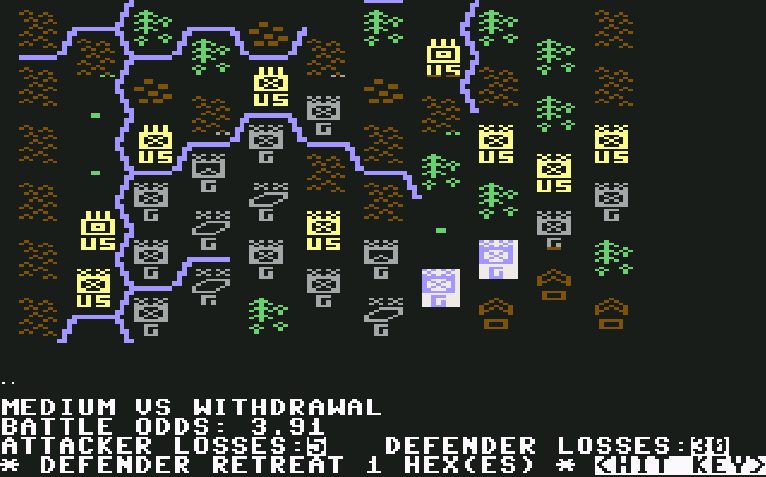
Rating: Very bad
B. UI , Clarity of rules and outcomes
Just to sum up how the game works: during the movement phase the computer cycles once through your units and asks you to move them. Then, during the combat phase, the computer cycles through the enemy units and asks you if you want to attack them. If so, the computer will then cycle through your units able to attack and ask you whether that unit participates in the attack.
This is by all accounts an unmitigated disaster. The most important problem is that at any given moment, you only see the combat value of the unit you are cycling through. You have no way of knowing whether some enemy unit is strong or weak, and whether your own units are able to make a difference – except if you have an excellent memory and remember what you saw as the computer cycled through the units of either side earlier on.
Even worse, the game only tells you whether a unit is “out of supply for the attack” (a condition that has a chance to happen depending on your total available supply & fuel) as it cycles through them when you allocate attackers. This means that you target an enemy unit, select a first unit of yours to attack, and then realize with horror that the other units you counted on for the attack are actually out of supply. “Sorry buddy, change of plan, you’re on your own for this attack! “
This is the same across versions, and again is a letdown compared to Langley’s earlier games :
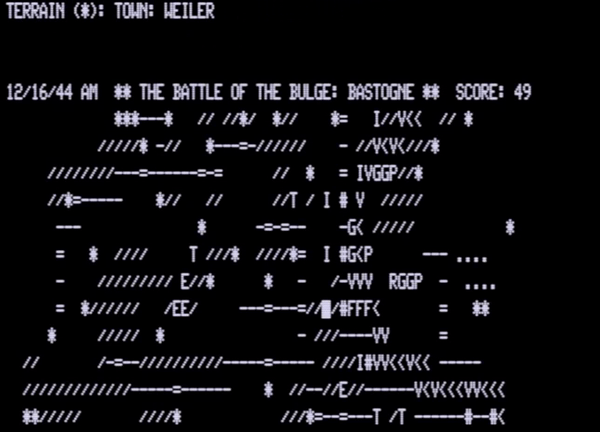
Since you cannot investigate a tile, you cannot check what type of terrain a unit is currently occupying, and you can very easily forget that, say, this tile is where Bastogne is…
Last complaint: the manual is lacklustre. It does not explain how combat is resolved. The game asks which attack strategy (“major”, “medium”, “light”, “recon”) or defence strategy (“counter-attack”, “hold position” “delaying action”, “withdrawal”) you want to use – but it never explains what those strategies do. I still don’t know if there is a difference between a “Light Attack” and a “Recon Attack“, or more critically if say “Hold Positions” actually decreases your chance to retreat compared to the other options, or if it is just a name and the equivalent of “Medium Attack“. Very frustrating.

Rating: Terrible
C. Systems
Overall, the game really is a “transplanted” wargame.
To start with the most traditional part: movement and combat.
Movement points depends on unit type and various random factors. Obviously, entering different terrains has a different cost in movement points. Less typically, entering into an enemy zone of control consumes additional movement points, but only stops the movement of infantry: tanks can carry on.
As I explained, crossing the river takes a random amount of movement points – if it is more than available to the player, the game will claim there is a “traffic jam” or “a bridge blow-up“, and the movement will end there. Allied units often have so few movement points that they can fail to cross rivers even if it is the only action they tried to do.
As for combat, each unit has a combat value which serves as both attack strength and hit points. In combat, the game compares the combat value of everyone involved (there can be only one defender) and then applies the following modifiers:
- terrain,
- lack of supplies, for attackers only
- attack strategy, note that the game can randomly decide that your commander disagrees or misunderstands your order and changes them randomly (“strategy altered“)
- defence mode, with the same “strategy altered” caveat,
- combat state: a unit starts with a state between 0 and 7 and gains one every turn, but loses 2 for every hexagon travelled,
- artillery used by both the defender and attacker,
Based on this, the game does some mumbo-jumbo and outputs a result: how much combat value is lost by each side and whether one side retreats, and if so by how much (1 to 3 tiles). Units which cannot retreat or which retreat in enemy ZOC lose additional combat value.
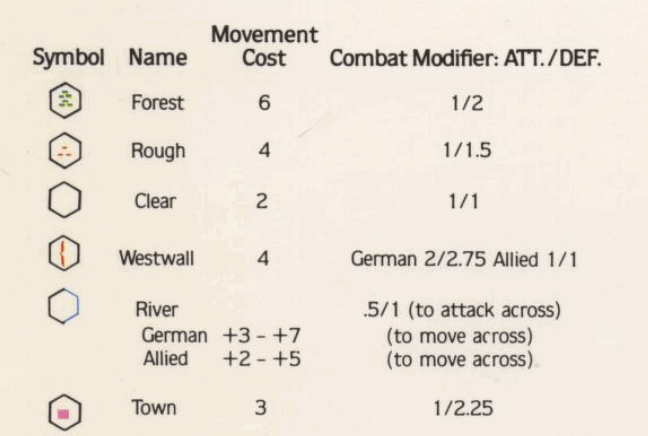
Loss of combat value is relatively limited – I don’t think I saw any unit lose more than 15 in a combat, and even then it is rare. One exception: if a unit is below 25 combat value, it risks destruction, in which case it loses everything.
If a unit retreats, the other side can pursue by the same number of tiles – terrain and rivers be damned. Sometimes, a unit in pursuit can attack again, and possibly win and pursue again – moving several times faster in this way than it could with a normal movement. But since you can only attack as the computer cycles through units, if your potential target has already been cycled through, well, sorry, your second attack is just wasted. Come back next turn!
This “cycling” process is the most aggravating. It makes each part of the game frustrating. Sometimes you want to move a unit in the front before a unit in the back – not possible. Sometimes, you want to know the result of one battle before committing to another – not possible.
At least, this issue was fixed for movement in the Commodore 64 version with a second cycle for movement (similar to Operation Apocalypse) so you can move the unit in the front first.

The game also manages supplies, at two levels :
- Local supply depends on how isolated and surrounded by enemies a unit is. Obviously, if you are not fully supplied, your combat capacity will go down – down to 50% at “isolated”.

- Strategic supplies correspond to what is available in the theatre: “General Supplies” only for the Allied, “General Supplies” and “Fuel” for the Germans.
- Both are used when moving or attacking – tanks use more,
- Both are slightly restored at the beginning of a turn,
- The closer to 0 general supply is, the higher the chance that the unit fights at half-combat value
- The closer to 0 fuel is, the higher the chance that the German units get reduced movement.
Once again, the cycling process makes this feature frustrating. There is no way to first move the armoured division that needs to do an attack to make sure it has fuel & supplies.
Final note, depending on the weather (which is getting better over time), the German player will lose lump sums of supply and fuel, and receive fewer movement points each turn.

Overall, the rules are unclear, unfair and unrealistic. They make the game frustrating to play.
Rating: Terrible, presumably just “very bad” for the Commodore 64 port which at least gets rid of the cycling problem.
D. Scenario design & Balancing
There are only 2 scenarios (a short one and a long one) and, while I can’t say for the short one, the long one does not seem very balanced – the Allies have a significant advantage – though it can be balanced by giving the Germans extra combat value at the beginning of the battle.
The DataDrivenGamer played the game as the Allies, if you’re interested in hearing from the other side.
Overall, I found the scenario frustrating to play as the Germans as I feel it aggravates the weaknesses of the ruleset: the many rivers, the narrowness of the front means that if your unit on point is cycled last, then all your units will stop.
Interestingly, the TRS-80 map is very different from the map on the other platforms. Rivers are also different: they are not between tiles, but are tiles themselves. I haven’t tested enough to know whether it plays better or worse.
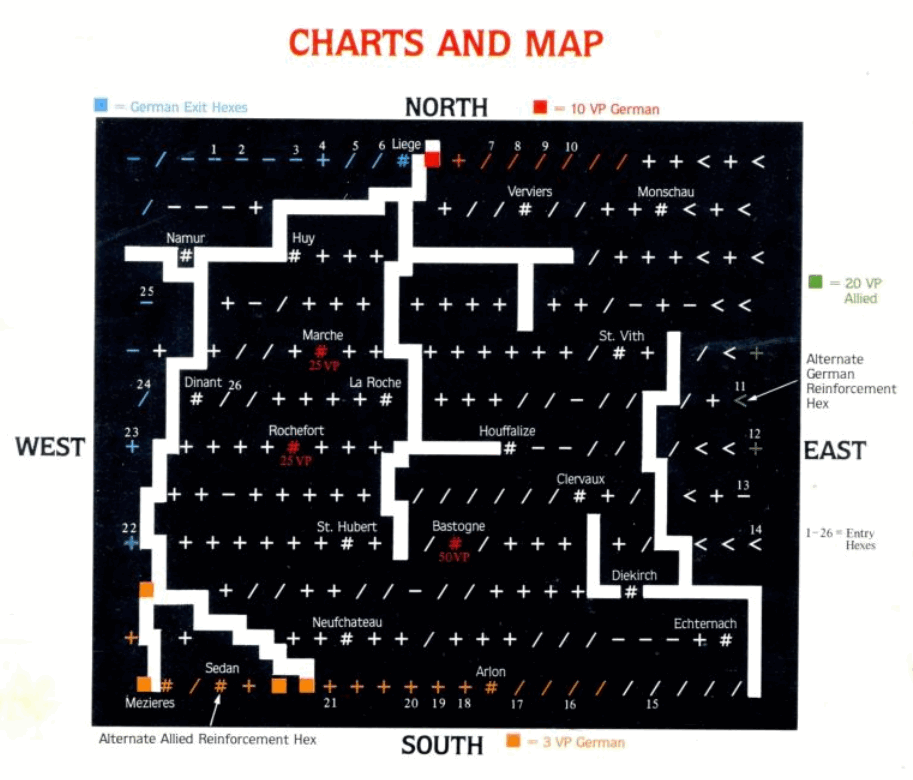
As for the AI, it is average. It is aggressive and tries to isolate units, but some of its actions are hardcoded and those trigger strange behaviours. For instance, in my AAR, the AI did not try to occupy Bastogne when both its forces and my forces were one tile away: that task had been allocated to the 101st Airborne which was quite simply not around. When I played as the Allies on the other end, the AI ignored Bastogne or Rochefort when it could take them easily with some of its units: those units had not been the ones earmarked for the cities.
Rating : Very bad
E. Did I make interesting decisions?
I have to admit I did make some interesting decisions: where to focus my push, when to attack and when not to in order to save men, supply and fuel, …
But too many of those calls were nullified because of the cycling problem. By the middle of the game I was so irritated by the game that I stopped caring that much, and thought less and less about my moves.
F. Final rating
Totally obsolete.
Contemporary Reviews
Tigers in the Snow received few reviews for an SSI game, and these were anything but enthusiastic. Even Computer Gaming World, usually praising anything coming from SSI, was mellow. In the April 1982 issue, Richard Charles Karr describes several points of frustration mirroring some of mine, including the fact that units block each other and the lack of representation of the roads. He also, more strangely, complains that you cannot break down and reform units – not that I know any game doing that in 1981. He concludes by calling the game “enjoyable“, which is pretty much as low as Computer Gaming World ever went at that point for an SSI game.
The 1983 Book of Atari Software gives the game mostly Cs, calling the documentation confusing (especially on combat). The description claims “it is not as versatile or engrossing as […] [Operation] Apocalypse” but it compares the game favourably to Computer Conflict – quite a low bar in my opinion, and personally I had more fun with Conflict.
In France, the game had a mixed reception. Jeux & Stratégie includes it in its October/November 1984 list of 33 best computer games, but oddly enough the review says the game doesn’t stand out from the crowd. On the other hand, in its reviews of all existing computer wargames in March 1984, Tilt gives only two 2 stars out of 6.
In any case, even though the popularity of the Battle of the Bulge gave the game more longevity and ports than its intrinsic quality should allow (it survived in the SSI catalogue until Spring 1987 !), Tigers in the Snow did not pass the test of time. In its 1993 review of all existing wargames, Computer Gaming World would give the game only one star, with the following review: “An operational simulation of the Battle of the Bulge, its primitive graphics, play mechanics and poor user interface have been superseded by more recent efforts.”
9 Comments
Not sure what is more ridiculous in the Panzerlied movie scene: “too many boys” clearly played by 30-year old actors (https://en.wikipedia.org/wiki/Dawson_casting), the symphonic orchestra breaking into song, or the hilariously incompetent lip-syncing in german.
Personaly I had a hard time believing the commander would express doubt in front of a group of (green) subordinates. Also thank you for the Dawnson casting, I didn’t know that term.
Something about Tigers in the Snow seems to have made it easy to port, and it eventually supported Atari (1982), IBM PC (1982) and Commodore 64 (1983) – very few other SSI games supported that many platforms – though the versions have some differences.
Three of the five games by SSI’s Tactical Design Group had simultaneous Apple/Atari/TRS-80 releases and got ported to PC & C64 later down the line. Shiloh, which I’m pretty sure was their first game, did not get the PC/C64 ports, and Breakthrough in the Ardennes skipped TRS-80 probably because nobody was using them any more and PC for some other reason.
What makes you think that Shiloh was their first game ? All the advertisements I saw (including the SSI catalog) display both at the same time so I always assume they were released at the same time (around October 1981).
The engine is almost identical but Bulge has more features. This suggests to me that Shiloh was largely completed first, perhaps as a proof of concept for the engine, and Bulge expanded on it. But they were probably released at the same time.
The title Tigers in the Snow reminded of Tigers in the mud, a book written by a Panzer commander on the Eastern front, not that interesting in itself, but it got a manga adaption by Miyazaki (the Studio Ghibli dude), which is kinda weird considering how anti-war Miyazaki is and Miyazaki wasn’t a starving artist at the time.
I like the cover art on this one.
As all wargamers know, WW2 is designed to be played as Germany
It’s more like the player on the offensive makes all the decisions. Moreover computer players generally suck at offense. When they’re on defense often the best move is just to sit there. Make some local counterattacks and you’re golden.
I am also successful in pushing the Americans North and South, my only setback is that the 106th division is STILL holding and blocking a chunk of my forces with its zone of control.
The battered bastards of the 106th. I’m sure it was put there as speedbump but it’s just like the 101st.
There is a quote about this game I remembered so I went and dug it up. M. Evan Brooks, the author of the CGW 1993 wargames survey quoted on the article, maintained his list of computer wargames on his homepage until mid-2000’s. There he had an apparently updated or just longer description for the game with an interesting tidbit of information:
“An operational simulation of the Battle of the Bulge, its most serious problem was a user interface which refused to allow the player to access his units. Instead, the order of battle was cycled through three times, and pity the gamer who did not input his orders by the third time — primitive graphics, primitive play mechanics and a poor user interface.”
Archived version of the page for anyone interested: https://web.archive.org/web/20050212214638/http://www.pressroom.com/~meb/
At least it seems the designers were aware of the problem with units blocking other units that were behind them in the order queue. Obviously the solution of cycling through the units up to three times is less than ideal to say the least.